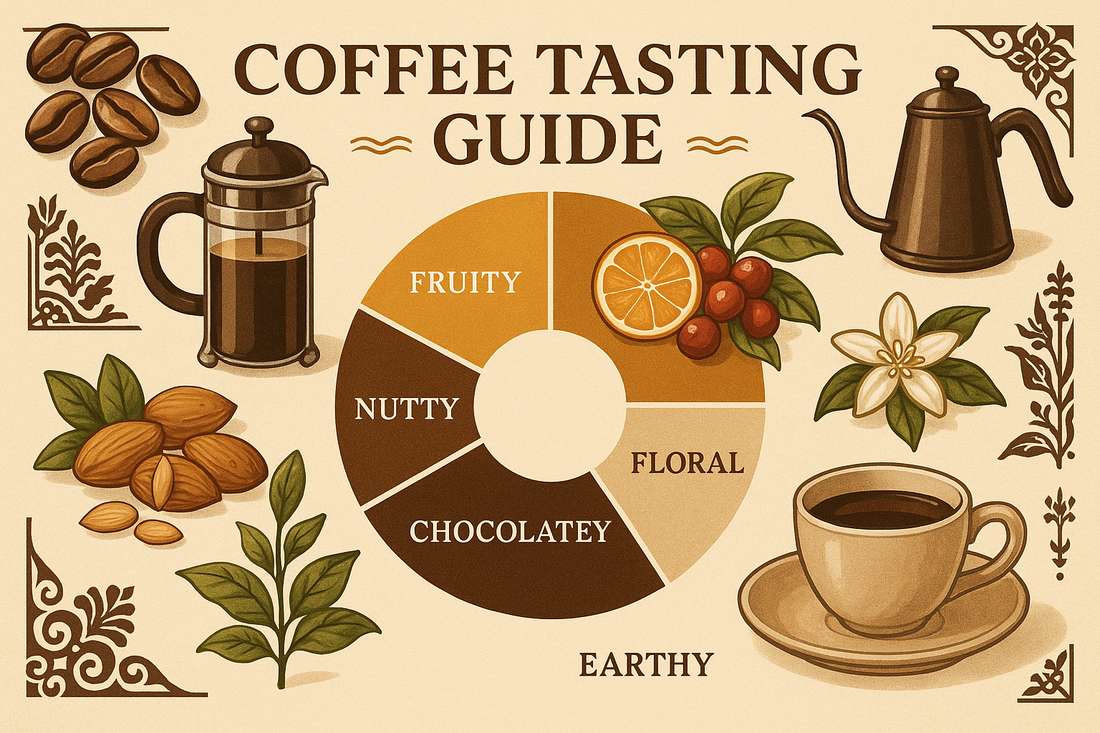
Understanding Coffee Flavor: A Complete Guide to Flavor Profile Keywords for Coffee Lovers
Share
For coffee aficionados, a cup of coffee is more than just a drink—it’s a complex sensory experience. Every sip can bring nuances of tropical fruit, dark chocolate, warm spices, or fresh flowers. However, to truly understand and appreciate this richness of flavor, it’s important to know the coffee flavor profile and the common keywords used in the world of coffee tasting. This article will help you understand these terms so you can explore the world of coffee with more confidence.
What is a Coffee Flavor Profile?
A coffee flavor profile describes the sensory characteristics of a coffee—encompassing its aroma, taste, aftertaste, acidity, body (texture), and overall balance. This profile is influenced by various factors, such as:
-
Bean Origin (e.g., Ethiopia, Colombia, Sumatra)
-
Coffee Varietal (Arabica, Robusta, or specific varietals like Geisha, Bourbon)
-
Processing Method (natural, washed, honey)
-
Roast Level (light, medium, dark roast)
-
Brewing Technique (V60, espresso, French press, etc.)
Common Keywords in a Coffee Flavor Profile
Here is a list of keywords frequently sought after and used by coffee enthusiasts to describe the flavor:
-
Acidity This does not mean sour like vinegar, but rather the brightness or crispness of the flavor.
-
Examples of descriptors: bright, citrusy, tart, wine-like.
-
Ethiopian and Kenyan coffees often have a high, refreshing acidity.
-
-
Body (Texture/Mouthfeel) Refers to the "weight" or viscosity of the coffee on the palate.
-
Examples: light-bodied (thin like tea), medium-bodied, full-bodied (thick like milk).
-
Sumatran or Brazilian coffees are typically full-bodied.
-
-
Flavor Notes (Tasting Notes) Specific descriptions of the emerging flavors, such as:
-
Fruit: blueberry, strawberry, citrus, apple, mango
-
Chocolate & Nut: dark chocolate, cocoa, almond, hazelnut
-
Floral & Herbal: jasmine, lavender, rose, mint, herbal
-
Spice & Earthy: cinnamon, clove, cedar, tobacco, earthy
-
Note: These notes do not mean the coffee is mixed with these ingredients, but rather that the natural compounds in the bean produce similar aromas and tastes.
-
-
Sweetness (Natural Sweetness) High-quality coffee often possesses a natural sweetness, not from added sugar.
-
Examples: honey-like, caramel, brown sugar, molasses.
-
-
Bitterness A natural component of coffee, especially in dark roasts. However, a balanced bitterness can add depth to the flavor.
-
Excessive bitterness often indicates over-extraction or low-quality beans.
-
-
Aftertaste The flavor that lingers after swallowing. It can be pleasant (clean, lingering, sweet finish) or uncomfortable (harsh, astringent).
-
Balance How harmoniously the flavor elements—acidity, sweetness, bitterness—blend into a pleasing whole.
-
Aroma Often more intense than the taste itself. Aroma can include: floral, fruity, nutty, smoky, or roasty.
Why is Understanding the Flavor Profile Important?
-
Helps you choose coffee according to your preference – If you like a light and acidic coffee, look for Ethiopian coffee with citrus notes. If you prefer a thick, chocolatey coffee, choose a Brazil or Sumatra.
-
Enhances the brewing experience – By understanding the flavor profile, you can adjust your brewing method and water-to-coffee ratio to highlight the coffee's best characteristics.
-
Communication with baristas or roasters – You can be more specific when ordering or asking: "I'm looking for a coffee with a medium body and berry notes."
Tips for Training Your Coffee Palate
-
Taste Blindly: Compare two different coffees without knowing their origins.
-
Use the Coffee Taster’s Flavor Wheel: A visual tool from the Specialty Coffee Association (SCA) that helps identify flavor nuances.
-
Document Your Experience: Keep a simple coffee journal—note the origin, brewing method, and the flavor keywords you detect.
-
Don't Be Afraid to Be Subjective: Describing flavor is subjective. If the coffee tastes like "Grandma's banana bread," that's perfectly valid!
So, brew your favorite cup, inhale its aroma, taste every layer of flavor—and let the coffee tell its story.
